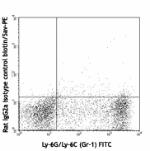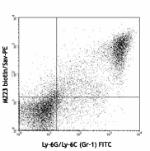- Clone
- MZ3 (See other available formats)
- Regulatory Status
- RUO
- Other Names
- DRAP-27, MRP-1, p-24
- Isotype
- Rat IgG2a, κ

-

C57BL/6 bone marrow cells stained with RB6-8C5 (Gr-1) PerCP/Cyanine5.5 and MZ3 FITC
| Cat # | Size | Price | Quantity Check Availability | ||
|---|---|---|---|---|---|
| 124807 | 25 µg | $47.00 | |||
| 124808 | 100 µg | $129.00 | |||
CD9 is a surface glycoprotein of the tetraspannin family. It is expressed on a variety of cells, including nerve, muscle cells and many cells of hematopoietic origin. CD9 is found to participate in forming a large molecular cell complex with other membrane proteins, such as MHC class II, CD19, CD5 and other TM4SF molecules. It is reported that CD9 is a marker of marginal zone B cells, B1 cells and plasma cells. The diverse functions of CD9 may largely depend upon its associated molecules on different cells.
Product Details
- Verified Reactivity
- Mouse
- Antibody Type
- Monoclonal
- Host Species
- Rat
- Formulation
- Phosphate-buffered solution, pH 7.2, containing 0.09% sodium azide.
- Preparation
- The antibody was purified by affinity chromatography, and conjugated with FITC under optimal conditions.
- Concentration
- 0.5 mg/ml
- Storage & Handling
- The antibody solution should be stored undiluted between 2°C and 8°C, and protected from prolonged exposure to light. Do not freeze.
- Application
-
FC - Quality tested
- Recommended Usage
-
Each lot of this antibody is quality control tested by immunofluorescent staining with flow cytometric analysis. For flow cytometric staining, the suggested use of this reagent is ≤ 1.0 µg per 106 cells in 100 µl volume. It is recommended that the reagent be titrated for optimal performance for each application.
- Excitation Laser
-
Blue Laser (488 nm)
-
Application References
(PubMed link indicates BioLegend citation) -
- Won WJ, et al. 2002. J. Immunol. 168:5605. (FC, WB)
- Product Citations
-
- RRID
-
AB_1279324 (BioLegend Cat. No. 124807)
AB_1279324 (BioLegend Cat. No. 124808)
Antigen Details
- Structure
- 24 kd surface glycoprotein belonging to the tetraspanin (TM4SF)family which is characterized by four transmembrane-spanning domains and two extracellular domains.
- Distribution
-
CD9 is expressed in nerve, muscle, keratinocytes, fibroblasts and a variety of hematopoietic cells including monocytes, macrophages, granulocytes , platelets and activated T and B cells.
- Interaction
- CD9 may participate in forming large molecular complexes with other associated molecules.
- Cell Type
- B cells, Embryonic Stem Cells, Fibroblasts, Granulocytes, Macrophages, Monocytes, Platelets, T cells
- Biology Area
- Immunology, Stem Cells
- Molecular Family
- CD Molecules
- Antigen References
-
1. Boucheix C, et al. 1991. J. Biol. Chem. 266:117
2. Lanza F, et al. 1991. J. Biol. Chem. 266:10638 - Gene ID
- 12527 View all products for this Gene ID
- UniProt
- View information about CD9 on UniProt.org
Other Formats
View All CD9 Reagents Request Custom Conjugation| Description | Clone | Applications |
|---|---|---|
| Purified anti-mouse CD9 | MZ3 | FC,WB |
| Biotin anti-mouse CD9 | MZ3 | FC |
| PE anti-mouse CD9 | MZ3 | FC |
| FITC anti-mouse CD9 | MZ3 | FC |
| Alexa Fluor® 647 anti-mouse CD9 | MZ3 | FC |
| APC anti-mouse CD9 | MZ3 | FC |
| PE/Cyanine7 anti-mouse CD9 | MZ3 | FC |
| APC/Fire™ 750 anti-mouse CD9 | MZ3 | FC |
| PerCP/Cyanine5.5 anti-mouse CD9 | MZ3 | FC |
| TotalSeq™-A0813 anti-mouse CD9 | MZ3 | PG |
| PE/Dazzle™ 594 anti-mouse CD9 | MZ3 | FC |
| TotalSeq™-C0813 anti-mouse CD9 | MZ3 | PG |
| TotalSeq™-B0813 anti-mouse CD9 | MZ3 | PG |
Compare Data Across All Formats
This data display is provided for general comparisons between formats.
Your actual data may vary due to variations in samples, target cells, instruments and their settings, staining conditions, and other factors.
If you need assistance with selecting the best format contact our expert technical support team.
-
Purified anti-mouse CD9
-
Biotin anti-mouse CD9

C57BL/6 bone marrow cells double stained with MZ3 biotin (Lo... 
-
PE anti-mouse CD9

C57BL/6 bone marrow cells stained with RB6-8C5 (Gr-1) PerCP/... -
FITC anti-mouse CD9

C57BL/6 bone marrow cells stained with RB6-8C5 (Gr-1) PerCP/... -
Alexa Fluor® 647 anti-mouse CD9

C57BL/6 bone marrow cells stained with RB6-8C5 (Gr-1) PerCP/... -
APC anti-mouse CD9

C57BL/6 bone marrow myeloid cells were stained with Gr-1 Pac... -
PE/Cyanine7 anti-mouse CD9

C57BL/6 bone marrow myeloid cells were stained with Gr-1 Pac... -
APC/Fire™ 750 anti-mouse CD9

C57BL/6 bone marrow myeloid cells were stained with Gr-1 Pac... -
PerCP/Cyanine5.5 anti-mouse CD9

C57BL/6 bone marrow myeloid cells were stained with Gr-1 Pac... -
TotalSeq™-A0813 anti-mouse CD9
-
PE/Dazzle™ 594 anti-mouse CD9

C57BL/6 mouse bone marrow myeloid cells stained with Gr-1 AP... -
TotalSeq™-C0813 anti-mouse CD9
-
TotalSeq™-B0813 anti-mouse CD9
